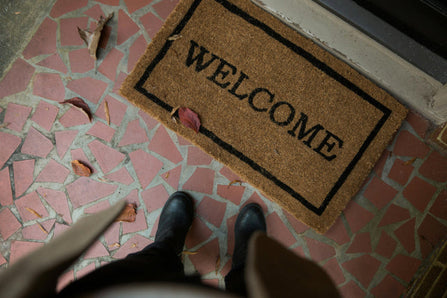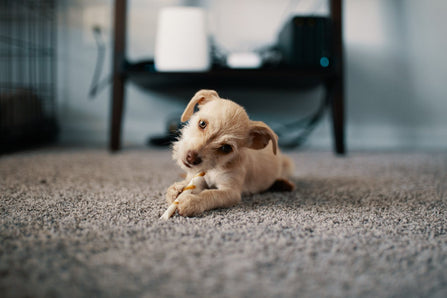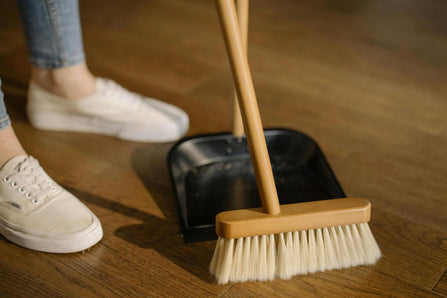How to clean laminate flooring - and what you should NEVER do…
Posted on by Online Carpets
How to clean laminate flooring - and what you should NEVER do…
During the warmer weather, we’re all naturally a bit more active outdoors, meaning more trips to the beach, more time in the garden, and simply more walks around town. As a result, an ever increasing amount of sand, dust, grass, and other outdoor debris are brought into our homes via our shoes.
And while the warmer weather hitting the UK is always something to be celebrated, it can sometimes feels like we’re spending more and more time cleaning our homes during the summer months rather than appreciating the beautiful outdoors.
With the flurry of nice weather we’ve had, the team at Online Carpets know it can be tempting to fill up a bucket of hot, soapy water and scrub away with a traditional mop to deep-clean any summer debris off your laminate flooring.
However, while laminate flooring is becoming increasingly popular for its price and versatility, we want to warn you of the potential problems that can arise if you’re thinking about doing this, or using one of the popular steam cleaning mops going viral on TikTok’s #CleanTok.
Can you mop laminate floors?
We’d recommend never mopping your laminate floors - using traditional mopping methods, at least.
This is because most laminate floorings are made using a fibreboard core. They’re generally made of four main layers of wood fibre to give the closest replication of natural wood floorings possible.
However, because the core of laminate is a wood product, it can soften and swell when exposed to too much water.
The swelling means that if your laminate is exposed to lots of water, it generally won’t return to its original dimensions when it's dried - meaning it's not exactly the best candidate for hot, steam mop cleaning or classic mop cleaning with lots of water.
If laminate flooring is continually steam cleaned or mopped, it can peel and wear away the design after it becomes waterlogged, and more often than not, water damaged laminate flooring will need to be completely replaced.
So, what does laminate floor water damage look like? There will be many visible signs showing water damage, including the edges between the joints looking swollen or blistered, any peeling to the finish of your laminate flooring, and walking over and hearing a ‘squishing’ sound.
As mentioned, water damaged laminate flooring will need to be replaced, but if it’s just a couple of boards affected, you won’t have to rip up the entire floor and start again.
If you have leftover boards from when you originally installed the laminate, use those. If not, order a couple of free samples of laminate to try and find your best match.
However, there are plenty of ways to care for laminate that are arguably less strenuous than the mopping, resurfacing, and polishing that traditional wooden flooring requires, making it an excellent choice for busy homes - especially for ones with pets and children.
If you’re putting laminate flooring in places of your home like your kitchen or entryways, why not consider some of our water-resistant laminate, such as the Traditions range from Balterio?
It uses HydroShield protection technology and a renowned click system, which prevents water and other liquids from seeping into the joints.
Can you mop LVT flooring?
Again, we’d warn against using too much water or using a traditional mop to clean your LVT flooring, as it’s likely to do the same damage as it would to laminate - or vinyl flooring, for that matter.
Just like laminate, LVT is made up of many layers of material, also making it sensitive to moisture.
For the best results with the simplest of methods, take a look at our full guide on the best way to clean laminate floors below.
The best way to clean laminate floors
Cleaning and maintaining your laminate flooring doesn’t have to be complicated. Remember, just like the rest of your home, when it comes to cleaning laminate flooring, the key is ‘little and often’.
Check out our best ways to clean laminate floors below:
Removing debris
First, you’ll want to remove any grit, debris, or dust from your laminate floors using a dry dust mop, wipe, or vacuum.
If you’re vacuuming, ensure your vacuum is suitable for hard-surface floors. Many modern vacuums have two settings on them - one for carpet and one for hard floors, which allows you to lift and drop the beater bar function.
While sweeping up any debris might seem like the obvious, cheaper choice, the bristles on a traditional broom can push the dirt into the cracks between the laminate boards, making it even harder for you to clean up.
How often you vacuum depends on your own personal comfort levels at home, but as a general rule of thumb, we recommend that you vacuum the stairs once a week, and everywhere else at least twice a week.
However, for high-traffic areas, like your entrance porch, hall, or kitchen, you should consider vacuuming daily to keep on top of things. Depending on where in your home your laminate flooring is, will depend on how often you should vacuum it.
Spot cleaning
While how often you clean the debris off your laminate floor will depend on where the flooring is in your house, you’ll want to ensure you keep on top of spot cleaning your laminate floor daily.
This means immediately cleaning up any spillages as you go.
You can spot-clean any stains or spillages using a simple white vinegar solution. The acidic nature of white vinegar makes it powerful enough to dissolve grime, grease, and bacteria without damaging the stain on your laminate floor. However, be sure to dilute it, or use a pre-diluted spray when doing this.
Deep cleaning
In addition to the quick daily maintenance you take on your laminate floors, we recommend giving your laminate floors a deep clean at least once a fortnight.
When it comes to your deep cleaning, you should use either a wet floor/ ‘speed’ wipe or mix your own DIY laminate floor cleaner and use a damp mop (also known as a microfibre mop).
Many popular brands offer speed mop wipes for hard flooring, including the viral ‘Flash’-brand mop. These are great solutions for laminate floors as they’re not wet enough for water to ‘pool’ on your boards.
However, if you’re conscious of adding yet another cleaning product to your routine, making a DIY laminate floor cleaner might be the solution for you - and you probably already have all the products sitting in your cupboard.
All you’ll need is some warm water, unscented dish soap, and white vinegar. The latter of which is often hailed as a secret cleaning weapon - with the likes of Mrs Hinch and the noughties cleaning gurus Kim and Aggie swearing by it.
We suggest mixing the solution of one part white vinegar and a couple of drops of dish soap to around 3-4 parts water. Then, simply dip in your microfibre mop - ensuring it’s not holding any excess water - and sweep across your floor.
You’ll know your mop is too wet if the water starts to pool on the floor and has difficulty drying. If this happens, be sure to wipe up excess water right away so it doesn’t have time to soak into the boards.



